This fermented honey garlic is the perfect thing to make to boost your immune system! Both honey and garlic have strong medicinal benefits, so you’ll want to have this delicious home remedy on hand for cold and flu season.
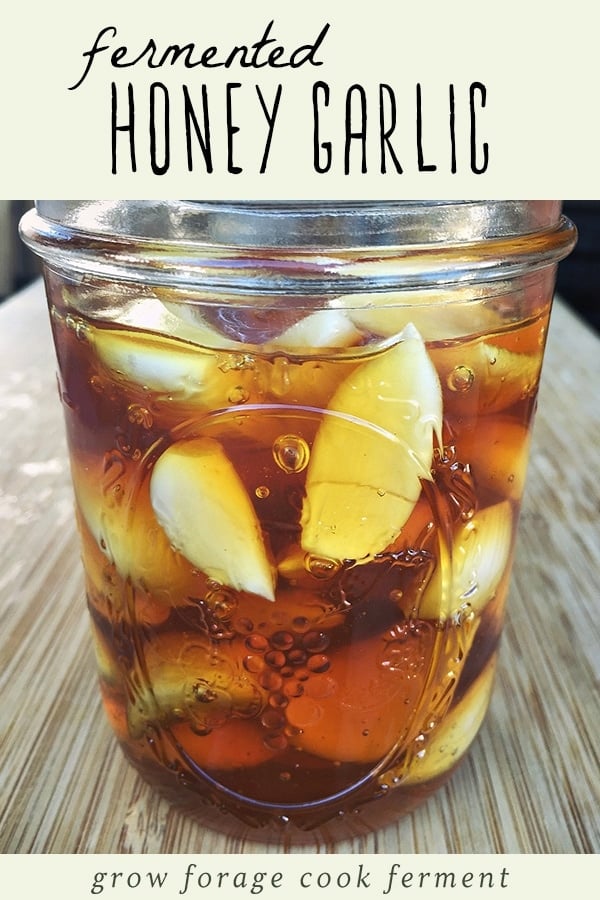
Want to save this post for later?
Fermenting Garlic in Honey
I’m really excited to share this post with you! Fermented honey garlic is something I’ve been wanting to try for a very long time.
I usually reserve my honey for mead making, but using it for other ferments intrigued me. Don’t ask me why I haven’t done it until now, because it’s the easiest thing in the world!
This tasty fermented garlic in honey can be used for many things, as good food and good medicine. Honestly though, I like to just eat it as is!
Fermented Honey Garlic Recipe
Making fermented honey garlic is so easy, it hardly needs a recipe!
Prepare the Garlic
The hardest and most time consuming part is prepping all of the garlic. Whatever size jar you use, you’ll want to fill it about 1/2-3/4 full of peeled garlic.
The quickest and easiest way to prep garlic is to place the side of a chef’s knife on top of a single clove and then give it a firm whack with the palm of your hand.
Don’t do it too hard, as you don’t want to crush the garlic, but just enough to lightly bruise the it. This will make it easy to peel, and will also release a bit of the garlic juice.
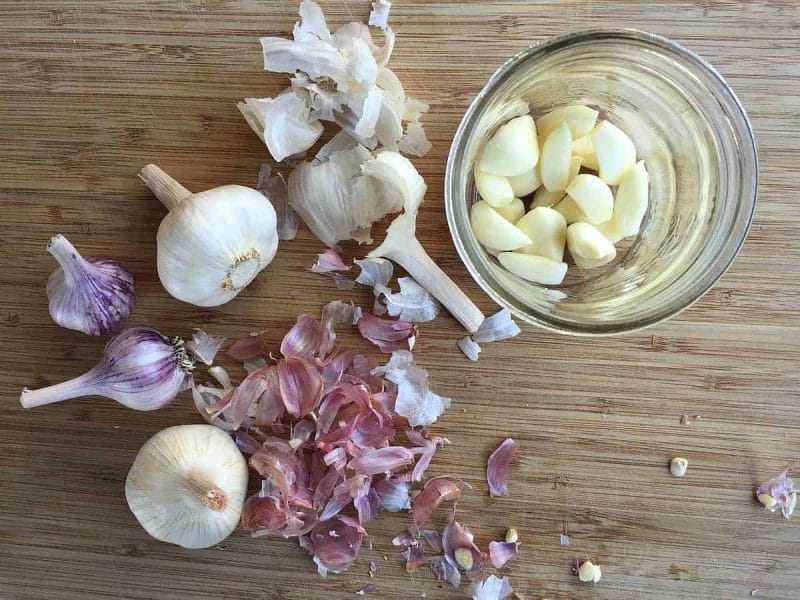
Add the Honey
Once you have enough garlic in your jar, pour in some raw honey to cover it. The garlic will probably float a bit and that’s ok.
It’s important to use raw honey to make fermented garlic in honey, as it will still have all the bacteria and wild yeast that is necessary for fermentation.
When liquid is added to honey, it jump starts the fermentation process. The small amount of juice from the garlic will create just enough liquid for fermentation to happen.
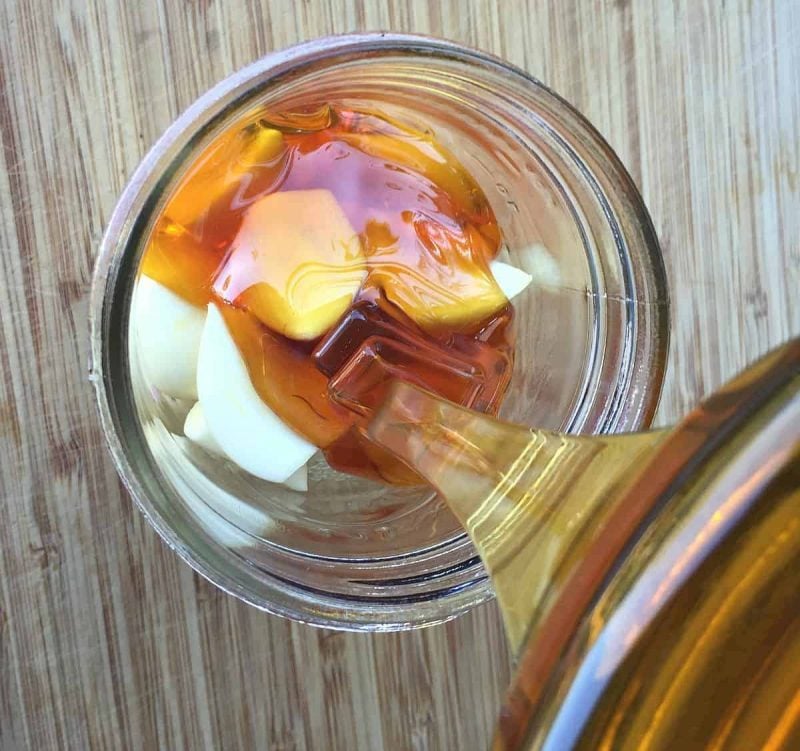
Cover and Flip
Cover the jar loosely with a lid to let the gasses escape, and put it in a dark place to ferment.
It’s a good idea to put a plate or something similar underneath the jar as it’s fermenting, as it will likely bubble up a bit and a little honey could possibly drip out.
It’s also important to gently turn the jar over every day or so, or whenever you think about it, to make sure that all of the garlic stay coated with honey.
Screw the lid on tightly before you do this! Then return it to it’s upright position and re-loosen the lid.
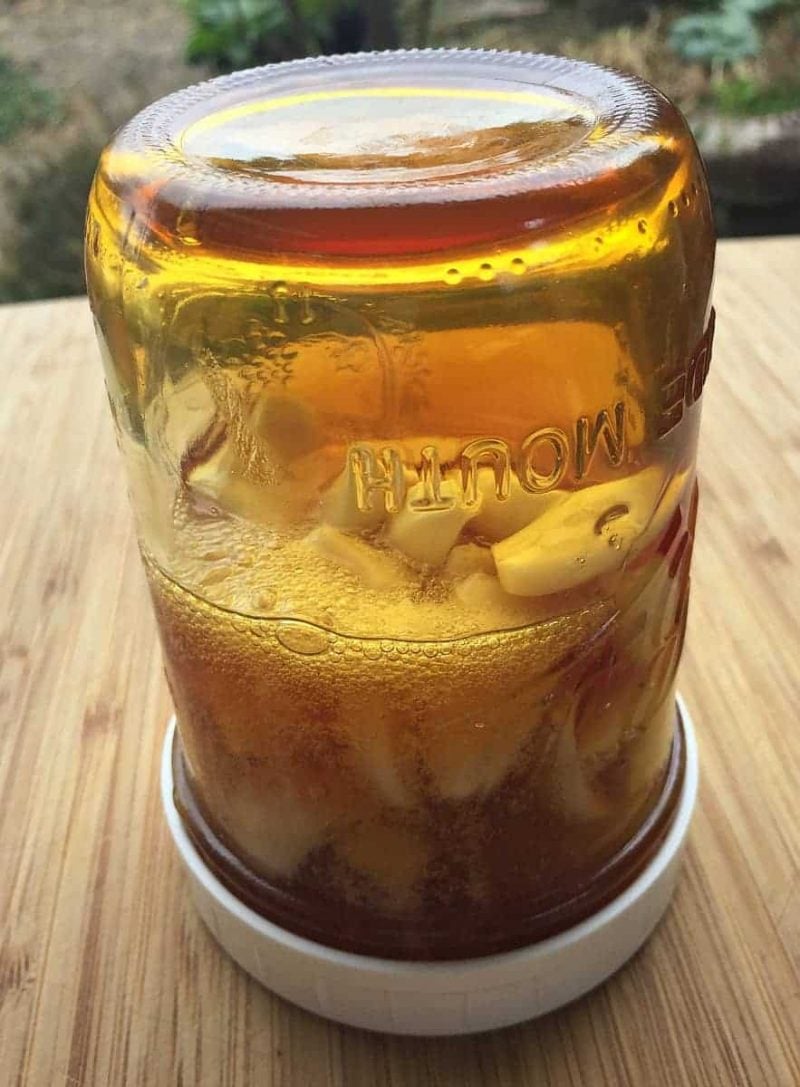
In a few days to a week you will notice some bubbles forming on the surface of the honey. Hooray!
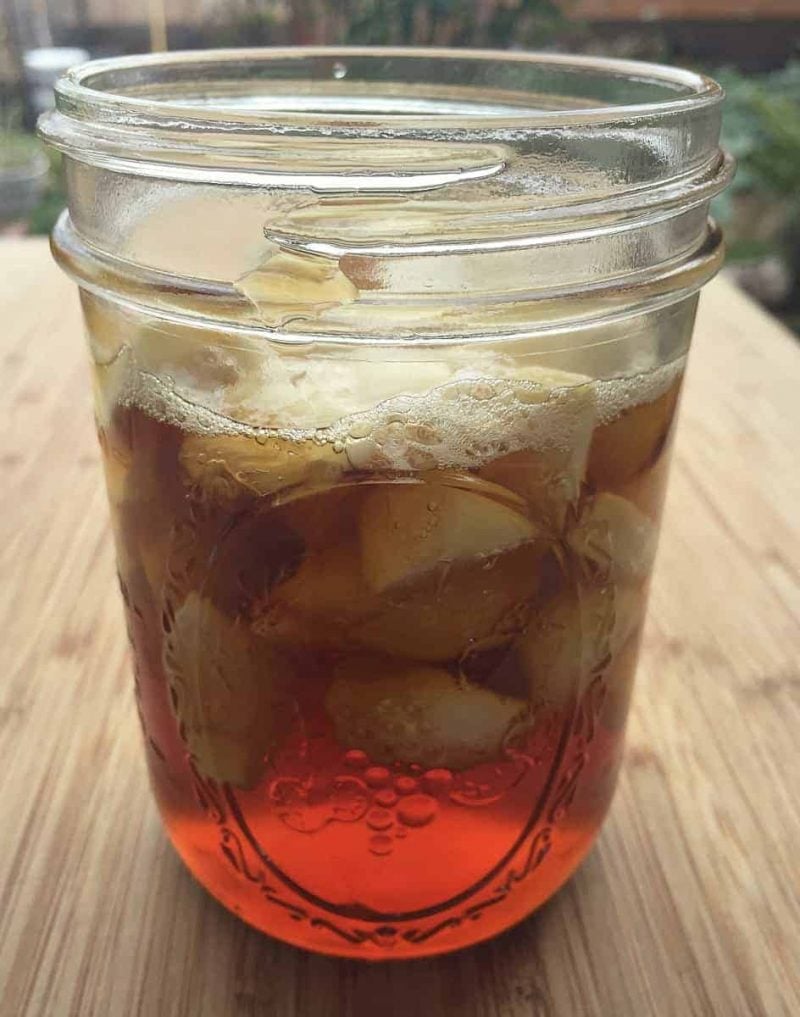
The honey garlic will ferment for about a month, but you can eat it at any time during the process.
The flavor will continue to develop over time, the garlic will mellow, and the honey will become much runnier.
Occasionally the garlic cloves turn a blue or green color due to a reaction during the fermentation process. While it may be a bit alarming, it is not harmful and the honey garlic can still be used.
Honey garlic will store well in a cool place for many months, or even a year or longer! I’ve kept some for over two years and it is still good.
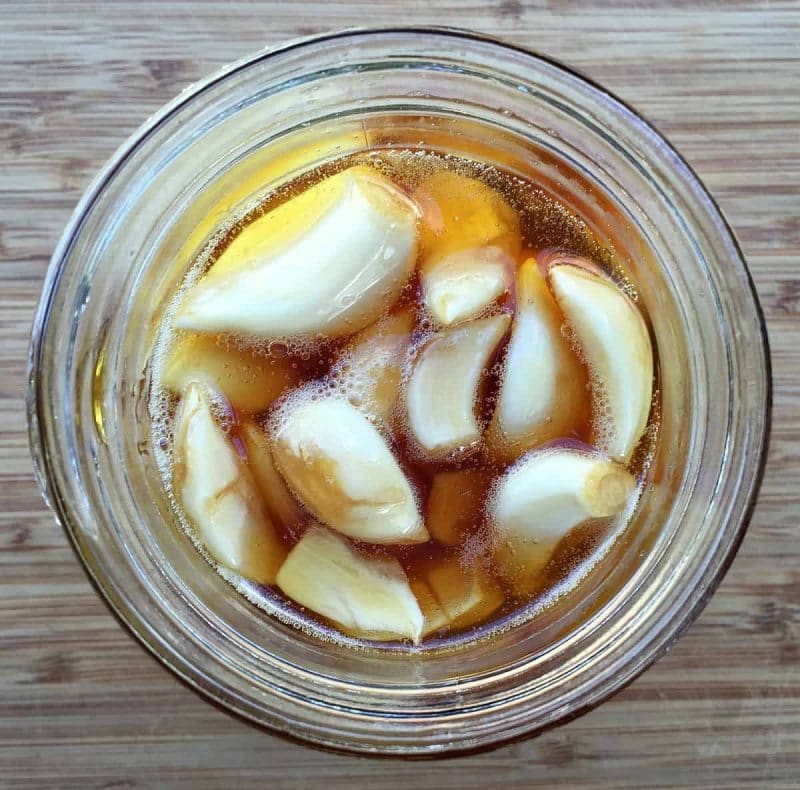
Using Fermented Honey Garlic
Now, how do you use this fermented honey garlic? That’s a good question, and it can be used in a variety of ways.
Both garlic and honey have strong medicinal properties, so it makes sense to use it as an immune booster or if you feel a cold or flu coming on.
Pop a whole garlic clove, or take a spoonful of honey (or both!).
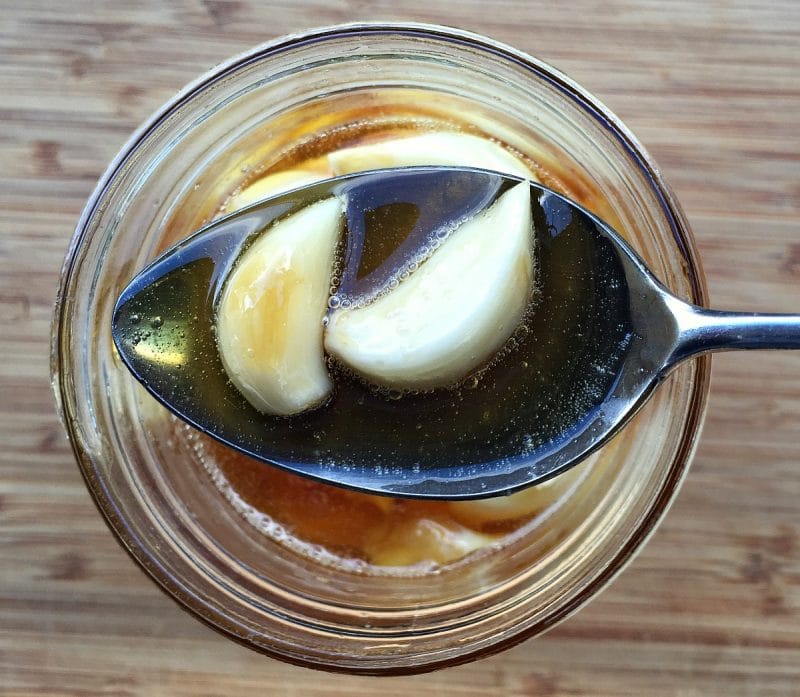
As you can probably imagine, honey garlic also makes a wonderful food!
It’s a natural in marinades and sauces, and would make a really tasty glaze for meats or veggies. Basically anything where you would normally use honey and garlic together!
Is Botulism a Concern in Honey Garlic?
I get this question a lot about fermented honey garlic! The short answer is no, botulism is really not a concern in this type of ferment.
While botulism can happen in garlic and oil preparations without added acidity, the fermentation process that happens here makes it very unlikely.
Raw honey is acidic, and while it can carry botulism spores (which is why it is not recommended for babies under 1 year), the level of acidity stops them from reproducing, which is what causes botulism.
If you are concerned about it, use a pH test strip. Botulism spores can’t reproduce with a pH of less than 4.6. Honey is usually around 3.9, but that can vary between brands.
If the pH is too high, add a splash of raw apple cider vinegar to add more acidity and retest. This is generally not needed, but I did want to mention it.
Honey garlic should not be given to babies under one year of age.
I really hope you make this yummy honeyed garlic! It’s super easy, and great to have on hand. I have a feeling it’s going to become a staple in our house!
Have you ever made fermented honey garlic? How do you use it?
More Fermented and Infused Honey Recipes
Enjoy these other recipes that showcase fermented and infused honey!
- Fermented Honey Cranberries
- Fermented Elderberry Honey
- Herbal Infused Honey
- Lilac Flower Infused Honey
Fermented Honey Garlic
Equipment
Ingredients
- 1 cup whole garlic cloves peeled and slightly crushed
- 1 cup raw honey or more, as needed to cover garlic
Instructions
- Place the peeled garlic cloves into a wide-mouth pint sized mason jar. Add enough honey to completely cover the garlic cloves. Make sure they are coated with honey.
- Place the lid on the jar loosely, then tuck into a dark place.
- Every day or so, tighten the lid on the jar and flip it upside down to coat the garlic cloves with honey. Loosen the lid again when you return it to the upright position.
- Within a few days to a week, you should see small bubbles start to form on the surface of the honey.
- The honey garlic will ferment for about a month, but you can eat it at any time. The flavor will continue to develop over time, the garlic will mellow, and the honey will become much runnier.
- Store in a cool place for many months or even a year, if not longer.
Notes
- It’s important to use raw honey for this recipe, as it has all of the bacteria and wild yeast that is necessary for fermentation.
- The small amount of juice from the garlic will create just enough liquid for fermentation to happen.
- It’s a good idea to put a plate underneath the jar during fermentation, as it will likely bubble up and a little bit of honey could possibly drip out.
- Occasionally the garlic cloves turn a bluish or greenish color during the fermentation process. While it may be a bit alarming, it is not harmful and the honey garlic can still be used.
- If you are concerned about botulism, use a pH test strip. Botulism spores can't reproduce with a pH of less than 4.6. Honey is usually around 3.9, but that can vary between brands.
- If the pH is too high, add a splash of raw apple cider vinegar to add more acidity and retest. This is generally not needed, but I do want to mention it.
- Honey garlic should not be given to babies under one year of age.

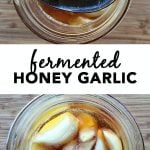
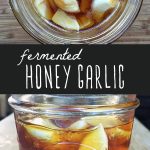
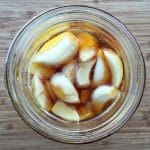

Hi
I have had my garlic honey jar for about 3mths most all the honey is gone but still have garlic in jar is it still safe to eat garlic? Or is it better to start over and eat garlic while honey is over the garlic?
As long as there isn’t mold, you can still eat the garlic.
I just made this for the first time 2 weeks ago. I think I added too much honey. Can I add more garlic even though it’s been a few weeks? Or should I just start over? Secondly, when it’s ready do you eat the garlic and the honey or just the honey?
Yes, that should be fine. I eat them both together, but you can do whatever you prefer.
Does anyone use fermentation weights to keep the honey submerged? Mine floats to the top immediately, even after I flip it. I have some weights I use for making sauerkraut and am wondering if I could use one in the honey garlic jar.
I haven’t used weights, but give it a try!
Mine seems to be fermenting (presence of bubbles), but the honey is so thick that I can’t just flip it to coat. Is it ok to put the jar in a warm water bath each time to loosen up the honey a bit?
That should be fine, just make sure it’s not too warm.
Hi! I’ve made the recipe and my garlic has turned a big greenish/blue. Do I remove the cloves and still use the honey or does the garlic need to stay in the honey all the time?
I’d feel better removing it and then just using /taking the honey. Would love your advice. Thanks so much!
That is totally fine and completely normal. I keep and eat the honey and garlic together, but you can do whatever you’d like.
Thank you! Do you end up refrigerating it or just store in the cupboard? And how long will it stay “good”!?
In a cool, dark cabinet it’ll last for a year or more.
I don’t consume sugars of any kind not even natural, I raise all of my animals holistically and I feed the garlic cloves to my dairy goat herd. I have a few goats that don’t care for raw garlic cloves but they love the honey garlic.
I made a batch of this using someone else’s recipe so didn’t use organic garlic-I purchased already peeled cloves. Plus my honey isn’t organic either but it is raw and unfiltered. How will I know if it’s fermenting? Is it the bubbles? I don’t want to toss the whole batch as I purchased a lot of honey and garlic. I also realized the lids I had for I had on the jars were the metal rings and flat seals. Will that affect the honey? I did switch them out. Thanks in advance for your response.
It could bubble or could not. It also could take on a “bready” smell. Some people have had success fermenting honey with non-organic garlic, so it could ferment, but I can’t really say definitively if it will or not. The lid shouldn’t affect the honey, but it may rust if it comes in contact with the honey.
Thanks so much!
Hi I made this recipe without raw honey, just regular local honey and organic garlic. It does seem to have fermented based on Bubbles and smell. Is it ok to consume since the honey wasn’t raw?
Yes. If you’re worried about the pH, you can add a splash or two of ACV.
My garlic and honey have been in the jars about 2/3 months, they fermented well. But when I tried the garlic it was so bitter, I had to spit it out. What have I done wrong.
Hi Jane. I don’t think you did anything wrong. The flavor isn’t for everyone, so maybe you just don’t like it?
Is it normal for the bubbles to die down after a while? I had a lot of bubbles for the first couple weeks but since then there aren’t many. Did I do something wrong?
No, that’s completely normal. Once the bubbles stop completely, it means it’s done fermenting and you can store with the lid closed in a cool, dark cabinet.
Thanks so much for all the information. I made mine nearly 2 months ago and it still needs to be burped every day or so. Can it continue to ferment for a really long time? How long does it usually ferment for?
Mine usually stops fermenting around a month, but yours could be fermenting more slowly? It’s hard to say.
I’ve consumed about half my jar of honey. Can I add fresh honey and extend the life of the jar, or will that not work?
It’s best to start a new jar each time to prevent cross-contamination.
You mentioned using raw honey should avoid any chances of botulism, my wife made some of this a couple months ago with non-fermented honey is there a possibility of getting it here? I had never heard of getting butulism from garlic this way but have since researched it and i can be a real possibility. Please advice.
Hi Rick. I’m not sure I understand what you mean by your wife using non-fermented honey. Did you mean she used honey that wasn’t raw?
I tried this last year, using raw honey , and completely failed, it never fermented. Used year old bulbs when new garlic harvest was ready, maybe not enough juice? Still have that jar of honey, haven’t tasted it, garlic has been removed, no spoilage.
Hello! I have made this over 5 times now. In my latest 2 batches the garlic is kind of wilted and soft now. Totally different texture and taste when I eat it. do you know what could have happened? Is it safe? I used the safe garlic and honey I always do.
Hi Tana. I’m not really sure why it’s different than your other batches, but the texture you describe is what my fermented garlic is like after it sits in the jar for a few months, so it’s likely fine. If you’re worried about the pH, add a splash or two of ACV.
Hi. I don’t enjoy swallowing the garlic cloves whole. If I cut them into smaller pieces before fermentation will that affect anything? Do people chew the garlic or swallow whole?
I don’t think anyone swallows the garlic whole. They chew it, just like any other food. You can chop them if you like.
We made this a couple of years ago and have not needed it until now. Our house can get up to 90 degrees in the summer. Will the heat cause it to go bad?
Probably not, but I can’t say for sure.
Should I use organic garlic? Does this t make a difference?
Also is this good for a cough? I have that strange tickle in my throat that causes me to cough or clear my throat all day long! :(
Yes, the recipe says that you should use organic garlic, otherwise, it may not ferment and yes, honey helps cough, so this should too!
Hi there! Just wondering if there is anything special I should be doing in the jarring process besides a clean jar, and just flipping and burping it?
Also, maybe a silly question but when you take a spoonful of this am I just eating the honey or the garlic too?
Thank you your amazing!
All the instructions are listed in the recipe. You can eat it however you want. I take a spoonful of both the honey and garlic and chew it in my mouth.
I have the same question and I don’t feel it is explained enough in the recipe above. I’m wondering do I clean the jars a certain way? Do they need to be sterilized a certain way? How tight do it put on the ? Does it need to sealed like canning? Or just screwed on normally? How often do I “burp” it? How do I “burp” it? Many, many questions.
I just clean them with soap and hot water. Canning would destroy all the fermented goodness (canning honey regardless of fermentation isn’t safe). Honey is shelf stable for many, many years when kept in a cool, dark location. I only leave the lid on the jar loosely so that gases can escape and tighten every day when I flip the jar to recoat the garlic that has floated to the top. It only needs to be burped (opening the lid) if you screwed the lid on tight.
My garlic floats so I can’t keep it under the honey???
The garlic needs only to be coated in honey, which is why I suggest flipping the jar every day.
I made this a couple of days ago. How do I know it’s ready to be used? Also, what if I used non organic garlic? I couldn’t find organic garlic at my local grocery store
Typically you’ll have active bubbles coming to the surface, but that can take longer than a few days depending on how warm it is in your home. Non-organic garlic may not ferment, but you could still try. The worst case scenario is that you end up with garlic infused honey.
Can I store mine in the fridge after it has fermented?
It’s best to keep it unrefrigerated, in a cool, dark cabinet.
Hello! Can’t wait to make this! Is there a special lid to use on the glass jar? Like a non metal lid? I am new to all this and would love any insight to make this properly.
Thank you!
I use a plastic one that fits wide mouth mason jars. You can usually find them alongside mason jars at any store that sells them!
Can I add more honey and garlic to a jar of already fermented honey garlic? Can I do this if the jar is almost empty? what if I started it a few weeks ago but want to add more garlic cloves? Is it safe to do?
It’s best to start a new jar each time to prevent cross contamination.
Can I use a fermentation lid for this or donyou just suggest a loosed lid?
That should be fine, but you’ll still need to flip the jar over daily with a tight fitting lid.
What are you thoughts on adding ground turmeric, black pepper, ground ginger, cayenne, and other herbs and spices? Also, what about adding ACV to the mixture at the beginning of the process – will it negatively affect the fermentation? Thanks in advance! Looking to give this out as a holiday gift this year!
Adding dried, ground spices will cause your ferment to have a grainy texture and because they’re not cooked, perhaps an off flavor. If it were me, I would add fresh ginger and turmeric and whole peppercorns. Yes, you can add ACV at the start. It shouldn’t interfere with fermentation.
What if you don’t see bubbles?
I would move it to a warmer location and see how it goes from there. Did you use raw honey and organic garlic? I’ve had the best results with those.
Can I use bagged, pre-peeled garlic cloves?
As long as they’re organic, they should ferment.
I started my batch mid November and it looks good so far. My house is starting to smell like fermented garlic though >_< can I keep my jar in the garage? Is there a low temperature it should not reach? Thanks.
Hi Shawn. Yes, you can keep it in the garage, but it will likely take longer to ferment. I wouldn’t keep it in temperatures lower than 45 degrees.
Hi!
For the fermented garlic recipe… must the honey be in liquid form??
Most honey producers in my area only have raw solid form honey…
What do you recommend?
Yes, it should be liquid. I would very, very gently warm the honey to liquid form before using.
I stay mostly at a marina on the coast in Texas. Would there be much access to foraging here?
Probably! I would look for a guidebook for your region.